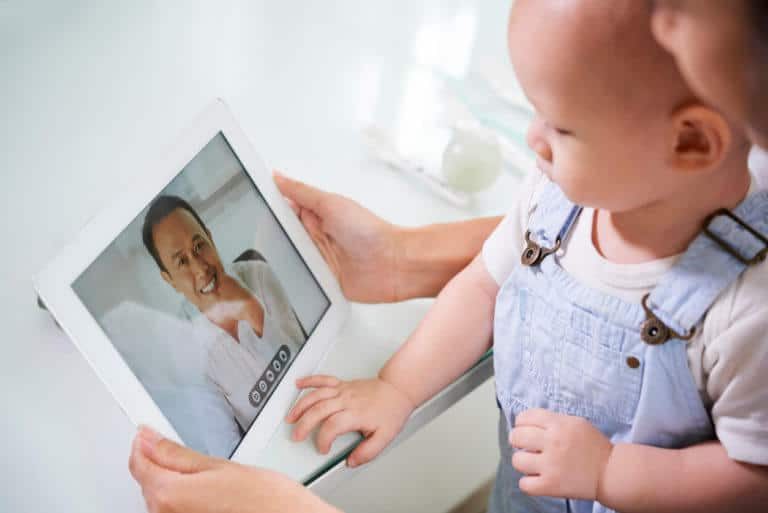In today’s rapidly evolving healthcare landscape, technology plays a pivotal role in improving pediatric home care. Innovations like telehealth, wearable devices, and mobile applications are transforming healthcare delivery. These technologies provide seamless access to medical expertise, enhance monitoring, and empower caregivers, ultimately improving patient outcomes and quality of life.
Telehealth: Bridging the Gap
Telehealth services have revolutionized pediatric home healthcare by offering a convenient and efficient way to connect families with healthcare professionals. It bridges the gap between in-person visits and remote care, allowing for continuous monitoring and support. This technology ensures that medical assistance is always within reach, regardless of geographical barriers.
Benefits of Telehealth in Pediatric Care
Telehealth offers numerous benefits, including increased access to specialized care, reduced travel time and costs, and real-time consultations. It facilitates the management of chronic conditions, provides timely interventions, and reduces hospital admissions. Additionally, telehealth enables healthcare providers to deliver personalized care tailored to each child’s unique needs.
Challenges and Solutions
Despite the advantages of telehealth, challenges such as limited technology access, unreliable internet connectivity, and patient privacy concerns persist. Solutions like providing subsidized devices, expanding broadband access, and implementing secure communication platforms can help overcome these barriers, ensuring that all families can benefit from telehealth services.
Wearable Devices: Monitoring Health in Real Time
Wearable devices are increasingly popular in pediatric care, enabling real-time health monitoring and data collection. These devices track vital signs, physical activity, and other health metrics, providing valuable insights for healthcare providers. Wearable technology allows for proactive care, early detection of issues, and timely interventions, improving overall health outcomes.
Advantages of Wearable Technology
Wearable technology offers continuous health monitoring, which is crucial for early detection and prevention of medical issues. It provides personalized data, helping caregivers and healthcare professionals make informed decisions. Additionally, wearables promote patient engagement and adherence to treatment plans, contributing to more effective and individualized care.
Ensuring Accuracy and Compliance
Ensuring the accuracy and compliance of wearable devices is essential in pediatric home healthcare. Proper calibration and validation of these devices guarantee precise data collection. Healthcare providers must also educate families on proper usage, ensuring that data is collected consistently and accurately, and maintaining high standards of care and patient safety.
Mobile Health Applications: Empowering Parents and Caregivers
Mobile health applications are vital tools that empower parents and caregivers by providing easy access to medical information, appointment scheduling, and direct communication with healthcare providers. These apps enhance the caregiving experience by offering features like medication reminders, symptom tracking, and educational resources, helping families manage their child’s health more effectively.
Key Features and Benefits
Mobile health applications offer key features such as real-time symptom tracking, secure access to medical records, and teleconsultation capabilities. These benefits allow parents to proactively manage their child’s healthcare, improve medication adherence, and facilitate timely medical interventions. The convenience and accessibility of these apps contribute to better overall health management.
Privacy and Security Concerns
Privacy and security are critical concerns in pediatric care, especially when using technology. Protecting patient information is paramount, requiring robust encryption and secure data storage solutions. Healthcare providers must ensure compliance with regulations and educate families about data privacy, fostering trust and confidence in technology-driven care solutions.
Electronic Health Records: Streamlining Care Coordination
Electronic Health Records (EHRs) streamline care coordination by centralizing patient information, making it easily accessible and secure. EHRs facilitate seamless communication among healthcare providers, reducing medical errors and improving care continuity. This technology supports efficient management of a child’s health history, treatment plans, and critical medical information.
Enhancing Care Through EHRs
EHRs enhance pediatric care by providing accurate and up-to-date patient information, and supporting informed clinical decisions. They improve the quality of care by enabling comprehensive tracking of health trends and responses to treatment. EHRs also facilitate easier access to medical records, empowering healthcare providers to deliver more personalized and effective care.
Overcoming Implementation Challenges
Implementing EHRs in pediatric home healthcare involves overcoming challenges like high costs, staff training, and system integration. Successful implementation requires careful planning, investment in user-friendly systems, and comprehensive training for healthcare staff. Overcoming these challenges is essential for leveraging EHRs’ full potential in improving patient care and operational efficiency.
Conclusion: A Bright Future for Pediatric Home Health Care
The integration of advanced technology in pediatric home healthcare heralds a promising future. Innovations like telehealth, wearable devices, and mobile apps enhance the accessibility, efficiency, and personalization of care. As these technologies evolve, they hold immense potential to improve health outcomes and the quality of life for children receiving home-based care.


